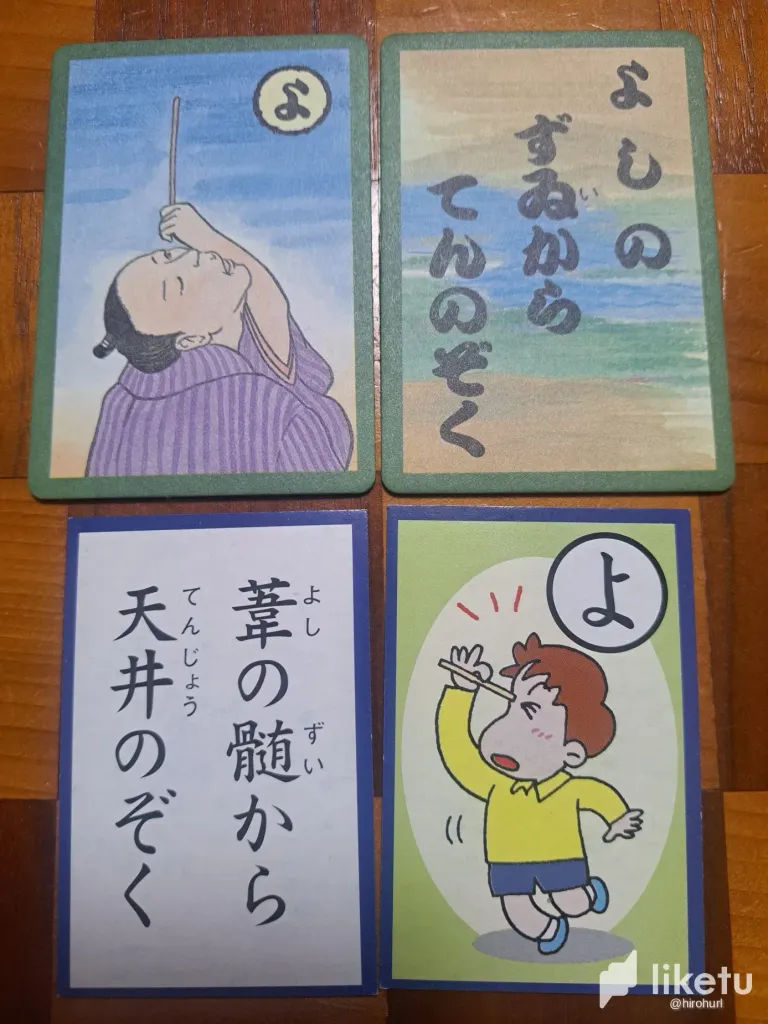
Have you ever tried to look at the sky through a straw? Or peered through a small crack between the tips of your index fingers and thumbs when you press them together?
Your view is incredibly limited, yet it can bring a distant star or the moon into sharper focus. But even then, you’re only seeing a fraction of the vast sky.
This feeling of peeping through a narrow opening onto the world can resonate with many aspects of life, especially when we, or others, form judgments based on a narrow perspective. It’s easy to think we know the whole story, but what we are viewing from our restricted perspective may not be the full picture.
That is the message of the fifteenth proverb in the Japanese Iroha Karuta deck. Both of my two Japanese Karuta decks agree that "looking at the sky through a straw" is the best proverb for the fifteenth character of the old Iroha syllabary, which is "YO" 「よ」. ("Yo" is the syllable that begins the proverb).
Here is the Japanese proverb:
「葦の髄から天を覗く」
YOshi no zui kara ten o nozoku
- 葦 = yoshi = reed
- の = no = genetive case ('s)
- 髄 = zui = pith
- から = kara = from
- 天 = ten = heaven (sky)
- を = o = object marker ("heaven" is the object of the sentence.)
- 覗く = nozoku = peep at
So a literal translation would go something like this:
"To peep at heaven from the pith of a reed!"
Yeah, it needs a bit of cleaning up to make any sense in English...
Taking the Pith
The thing which sticks out is the word "pith" (髄 = zui). In the case of a reed, the pith is the central, essential part of the plant. However, once this pith is removed, you're left with a hollow tube. To make more sense in English, it would be better to think of "peeping at heaven through the hollow of a reed," once the pith has been taken out. I think what happened in Japanese is that there was a shift in meaning, a semantic extension, so that 髄 went from literally meaning "pith" to symbolizing the core or essence of anything — a shift that also carries a metaphorical weight about perspective and understanding.
My Translation
I don't think you can do much better than this:
Looking at the sky through a straw.
However, this version sticks closer to the original:
Peering at the sky through a hollow reed.
Chatgpt versus Google Translate
I put the question to ChatGPT and Google Translate.
ChatGPT gave us:
"Looking at the sky through a reed's hollow."
The last part doesn't sound very natural, does it - "a reed's hollow."
Google Translate offered this translation:
"Peeking into the sky through the marrow of the reeds."
Oh dear! I think ChatGPT wins this one.
Variations in the Proverb
Were you beady-eyed enough to notice that the two versions of the proverb in the photo are actually slightly different from the version of the proverb that I provided?
The top deck is all in Iroha hiragana:
「よしのずゐからてんのぞく」
- よし = yoshi
- の = no
- ずゐ = zui (The old Iroha hiragana ゐ = "i" which is always written as 「い」in modern hiragana.)
- から = kara
- てん = ten
- のぞく = nozoku
This version omits the object signifier "o" - "ten nozoku" rather than "ten o nozoku," giving a more compressed feeling to the proverb.
The bottom (Daiso) deck also omits the "o" but changes the object from "heaven" - 天 = "ten" - to "ceiling" 天井 = tenjou, so might be translated as:
Peeping at the ceiling through a straw.
That's all from me for now as I'm peering at the bottom of an empty beer glass.
Cheers!
David Hurley
#InspiredFocus
For the best experience view this post on Liketu

 -
-  )
)